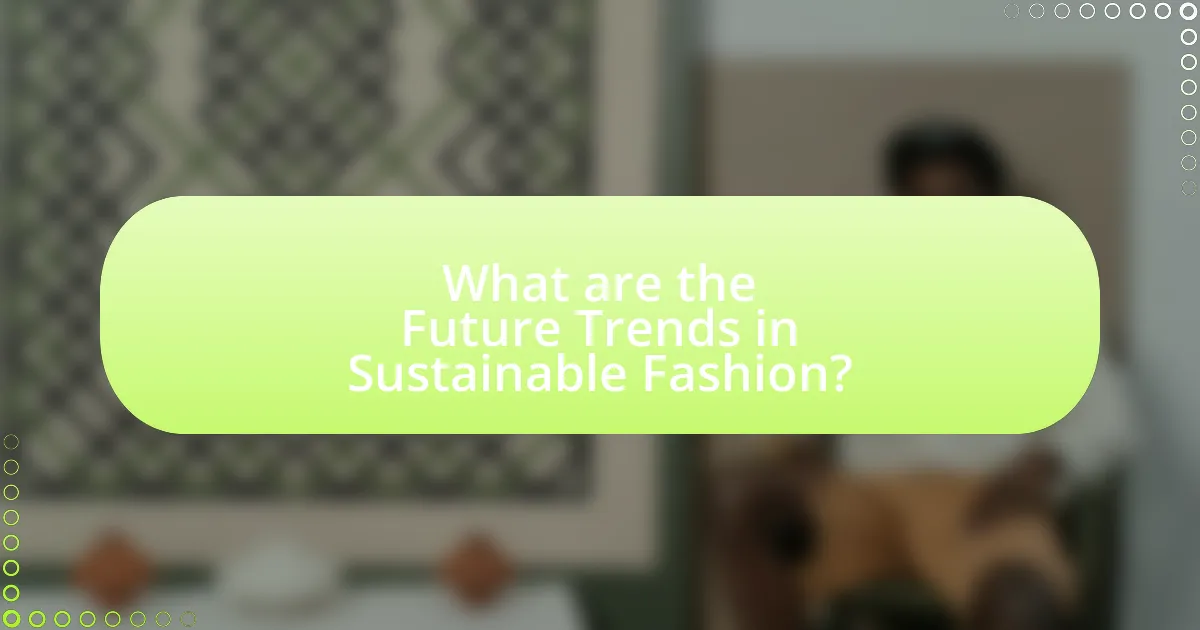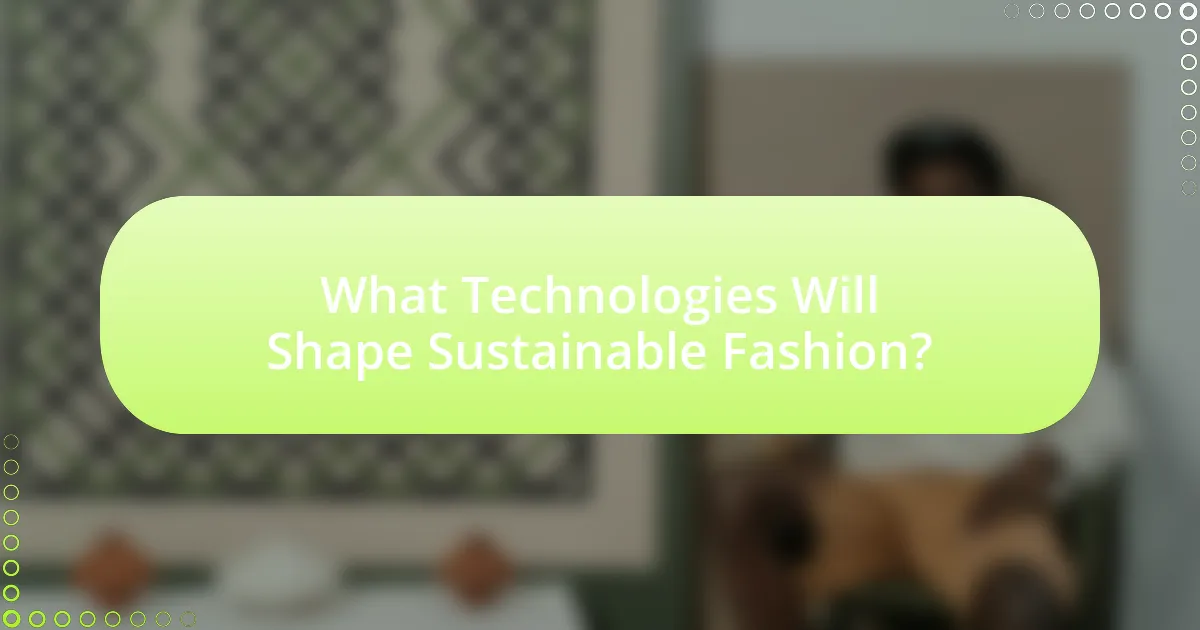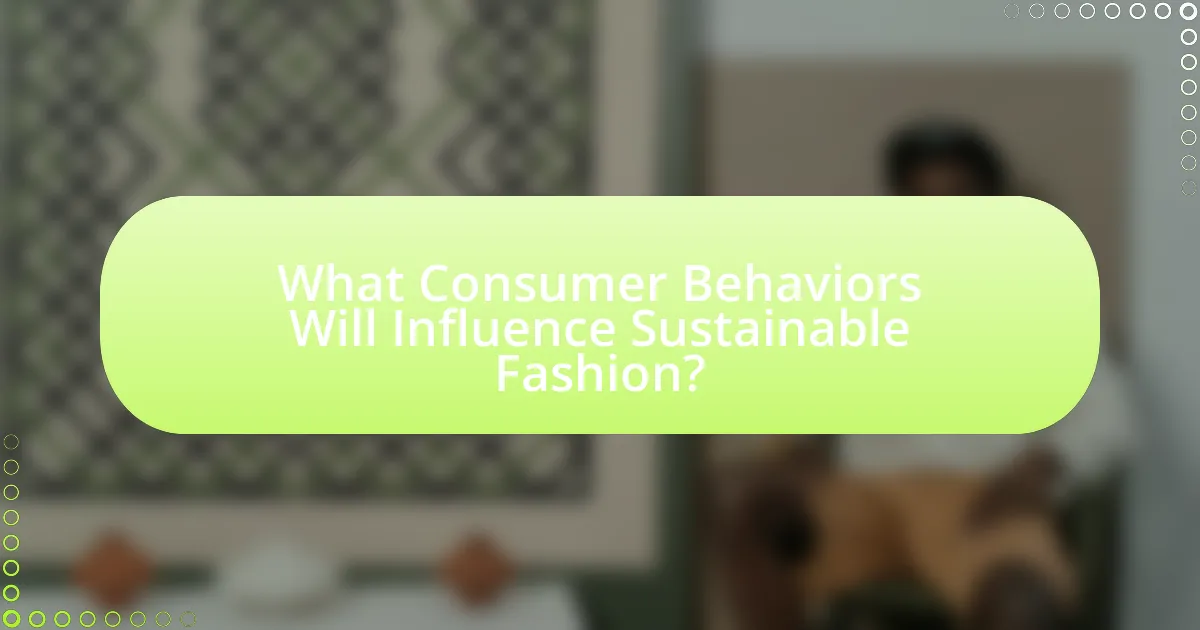The article focuses on future trends in sustainable fashion, highlighting the increasing adoption of circular economy principles, innovative materials, and technology-driven transparency. Key developments include the rise of biodegradable and recycled materials, advancements in recycling technologies, and the use of blockchain for supply chain transparency. Consumer preferences are shifting towards sustainability, with a significant percentage prioritizing eco-friendly practices in their purchasing decisions. The article also discusses the role of social factors, technological innovations, and ethical considerations in shaping the future of the fashion industry, emphasizing the importance of sustainability in addressing environmental impacts and consumer demands.

What are the Future Trends in Sustainable Fashion?
Future trends in sustainable fashion include the increased use of circular economy principles, innovative materials, and technology-driven transparency. Circular economy practices, such as recycling and upcycling, are gaining traction as brands aim to minimize waste and extend the lifecycle of garments. For instance, the Global Fashion Agenda’s 2021 report highlights that 60% of fashion brands are now adopting circular strategies. Additionally, the development of bio-based and recycled materials, such as those derived from agricultural waste or ocean plastics, is becoming more prevalent, with companies like Stella McCartney leading the way. Furthermore, advancements in technology, including blockchain and AI, are enhancing supply chain transparency, allowing consumers to trace the origins of their clothing and ensuring ethical production practices. This shift towards sustainability is driven by consumer demand for ethical practices, with a 2022 McKinsey report indicating that 67% of consumers consider sustainability when making fashion purchases.
How is sustainable fashion evolving in the next decade?
Sustainable fashion is evolving in the next decade through increased adoption of circular economy principles, innovative materials, and technology-driven transparency. Brands are shifting towards closed-loop systems, where products are designed for longevity and recyclability, reducing waste significantly. For instance, the Global Fashion Agenda’s 2021 report highlights that implementing circular practices could reduce fashion’s greenhouse gas emissions by 44% by 2030. Additionally, advancements in biodegradable fabrics and recycled materials are becoming mainstream, with companies like Stella McCartney leading the way. Furthermore, technology such as blockchain is enhancing supply chain transparency, allowing consumers to verify the sustainability of their purchases, which is crucial as 66% of consumers are willing to pay more for sustainable brands, according to Nielsen’s 2015 Global Sustainability Report.
What innovations are driving change in sustainable fashion?
Innovations driving change in sustainable fashion include the development of biodegradable materials, advancements in recycling technologies, and the use of artificial intelligence for supply chain optimization. Biodegradable materials, such as those derived from organic sources like mushrooms or algae, reduce environmental impact by decomposing naturally. Recycling technologies, including chemical recycling processes, allow for the transformation of textile waste back into raw materials, significantly decreasing landfill contributions. Additionally, artificial intelligence enhances supply chain efficiency by predicting demand and minimizing overproduction, which is a major contributor to waste in the fashion industry. These innovations collectively contribute to a more sustainable and responsible fashion ecosystem.
How are consumer preferences influencing sustainable fashion trends?
Consumer preferences are significantly influencing sustainable fashion trends by driving demand for eco-friendly materials and ethical production practices. As consumers increasingly prioritize sustainability, brands are responding by adopting practices such as using organic fabrics, reducing waste, and ensuring fair labor conditions. A 2021 survey by McKinsey & Company found that 67% of consumers consider sustainability when making a purchase, indicating a strong market shift towards environmentally responsible fashion. This growing preference is prompting brands to innovate and align their offerings with consumer values, thereby shaping the future landscape of the fashion industry.
Why is sustainability becoming a priority in the fashion industry?
Sustainability is becoming a priority in the fashion industry due to increasing consumer demand for environmentally friendly practices and the urgent need to address climate change. The fashion industry is one of the largest polluters globally, contributing to significant waste and carbon emissions; for instance, it accounts for about 10% of global carbon emissions and is responsible for 20% of wastewater. As consumers become more aware of these impacts, they are increasingly favoring brands that adopt sustainable practices, such as using recycled materials and reducing water usage. This shift is further supported by regulatory pressures and initiatives aimed at promoting sustainability, compelling brands to innovate and integrate sustainable practices into their operations.
What environmental impacts are prompting this shift?
The environmental impacts prompting the shift towards sustainable fashion include significant pollution, resource depletion, and waste generation. The fashion industry is responsible for 10% of global carbon emissions, contributing to climate change. Additionally, it consumes vast amounts of water, with the production of a single cotton t-shirt requiring approximately 2,700 liters of water. Furthermore, around 92 million tons of textile waste are generated annually, leading to increased landfill use and environmental degradation. These factors are driving the industry to adopt more sustainable practices to mitigate their negative effects on the planet.
How do social factors contribute to the demand for sustainable fashion?
Social factors significantly contribute to the demand for sustainable fashion by influencing consumer values and behaviors. Increasing awareness of environmental issues, driven by social media and activism, has led consumers to prioritize ethical consumption. For instance, a 2021 survey by McKinsey & Company found that 67% of consumers consider sustainability when making fashion purchases, reflecting a shift in societal norms towards valuing eco-friendly practices. Additionally, the rise of social movements advocating for social justice and environmental responsibility has heightened consumer expectations for brands to adopt sustainable practices, further driving demand for sustainable fashion.

What Technologies Will Shape Sustainable Fashion?
Technologies that will shape sustainable fashion include advanced materials, digital manufacturing, and blockchain. Advanced materials, such as bio-fabricated textiles and recycled fibers, reduce environmental impact by minimizing waste and resource consumption. Digital manufacturing technologies, like 3D printing, enable on-demand production, which decreases overproduction and inventory waste. Blockchain technology enhances transparency in supply chains, allowing consumers to verify the sustainability of products. According to a report by McKinsey & Company, the integration of these technologies can significantly lower the carbon footprint of the fashion industry, making it more sustainable.
How is technology transforming sustainable fashion production?
Technology is transforming sustainable fashion production by enabling more efficient resource use and reducing waste through innovations such as 3D printing, AI-driven design, and blockchain for supply chain transparency. For instance, 3D printing allows for on-demand production, minimizing excess inventory and material waste, while AI algorithms can optimize fabric patterns to reduce offcuts. Additionally, blockchain technology enhances traceability, ensuring that materials are sourced sustainably and ethically, which is crucial for consumer trust. According to a report by McKinsey & Company, the integration of these technologies can lead to a 30% reduction in resource consumption in the fashion industry by 2030, highlighting the significant impact of technology on sustainable practices.
What role do materials science and biotechnology play?
Materials science and biotechnology play a crucial role in the development of sustainable fashion by enabling the creation of innovative, eco-friendly materials. These fields contribute to the design of biodegradable fabrics, such as those derived from natural polymers or engineered microorganisms, which reduce environmental impact compared to traditional textiles. For instance, research has shown that bio-based materials, like those made from algae or agricultural waste, can significantly lower carbon footprints and resource consumption in the fashion industry. Additionally, advancements in materials science facilitate the recycling and upcycling of textiles, promoting a circular economy.
How are digital tools enhancing transparency in the supply chain?
Digital tools enhance transparency in the supply chain by providing real-time data tracking and visibility into every stage of the production process. Technologies such as blockchain enable immutable record-keeping, allowing stakeholders to verify the origin and journey of materials, which fosters trust among consumers and businesses. For instance, a study by the World Economic Forum highlights that blockchain can reduce supply chain fraud by up to 50%, demonstrating its effectiveness in ensuring authenticity and accountability. Additionally, IoT devices facilitate continuous monitoring of goods, ensuring compliance with sustainability standards and ethical practices, further reinforcing transparency.
What innovations in recycling and upcycling are emerging?
Emerging innovations in recycling and upcycling include advanced textile recycling technologies, such as chemical recycling processes that break down fibers to their original state, allowing for the creation of new fabrics. For instance, companies like Renewcell have developed a method to recycle cotton and other cellulose-based textiles into a new raw material called Circulose, which can be used to produce new garments. Additionally, upcycling practices are evolving with the use of digital tools, enabling designers to create unique pieces from waste materials, as seen in initiatives like the Fashion for Good program, which promotes the use of innovative materials and techniques to transform discarded textiles into high-quality products. These advancements are supported by a growing emphasis on circular economy principles within the fashion industry, aiming to reduce waste and promote sustainability.
How are brands implementing circular fashion practices?
Brands are implementing circular fashion practices by adopting strategies such as designing for longevity, utilizing recycled materials, and establishing take-back programs. For instance, companies like Patagonia and H&M have introduced repair services and recycling initiatives to extend the lifecycle of their products. According to a report by the Ellen MacArthur Foundation, transitioning to a circular economy in fashion could reduce greenhouse gas emissions by 44% by 2030, highlighting the environmental benefits of these practices.
What are the challenges in scaling up recycling technologies?
The challenges in scaling up recycling technologies include high costs, technological limitations, and market demand fluctuations. High costs arise from the need for advanced machinery and infrastructure, which can deter investment. Technological limitations refer to the inefficiencies in current recycling processes, such as the inability to effectively recycle certain materials, which restricts the volume of recyclables processed. Market demand fluctuations impact the economic viability of recycling operations, as inconsistent demand for recycled materials can lead to financial instability for recycling facilities. These factors collectively hinder the widespread adoption and effectiveness of recycling technologies in sustainable fashion.

What Consumer Behaviors Will Influence Sustainable Fashion?
Consumer behaviors that will influence sustainable fashion include increased demand for transparency, preference for eco-friendly materials, and a shift towards second-hand shopping. Consumers are increasingly seeking brands that disclose their supply chain practices, with 73% of millennials willing to pay more for sustainable products, according to a 2019 Nielsen report. Additionally, the rise of eco-consciousness has led to a growing preference for organic and recycled materials, as evidenced by the 2021 Global Fashion Agenda report, which highlights that 66% of consumers consider sustainability when making fashion purchases. Lastly, the popularity of thrift shopping and clothing rental services reflects a behavioral shift towards valuing longevity and reducing waste, with the resale market projected to reach $64 billion by 2024, according to ThredUp’s 2021 Resale Report.
How are consumer attitudes towards sustainability changing?
Consumer attitudes towards sustainability are increasingly prioritizing eco-friendly practices and products. Recent surveys indicate that over 70% of consumers are willing to pay more for sustainable goods, reflecting a significant shift towards valuing environmental responsibility. Additionally, a report by McKinsey & Company highlights that 67% of consumers consider sustainability when making purchasing decisions, demonstrating a growing awareness and demand for sustainable fashion options. This change is driven by heightened awareness of climate change and the impact of fast fashion, leading consumers to seek brands that align with their values.
What factors motivate consumers to choose sustainable brands?
Consumers are motivated to choose sustainable brands primarily due to environmental concerns, ethical considerations, and social responsibility. Research indicates that 66% of global consumers are willing to pay more for sustainable brands, reflecting a growing awareness of climate change and its impacts. Additionally, consumers are increasingly influenced by brand transparency and the desire for products that align with their values, such as fair labor practices and eco-friendly materials. A study by Nielsen found that 73% of millennials are willing to pay extra for sustainable offerings, highlighting the importance of sustainability in purchasing decisions.
How does social media impact consumer awareness of sustainable fashion?
Social media significantly enhances consumer awareness of sustainable fashion by facilitating the rapid dissemination of information and fostering community engagement. Platforms like Instagram and TikTok allow brands and influencers to showcase sustainable practices, share educational content, and promote eco-friendly products, thereby reaching a wide audience. Research indicates that 62% of consumers are more likely to engage with brands that actively promote sustainability on social media, highlighting the platform’s role in shaping consumer perceptions and behaviors.
What role do ethical considerations play in consumer choices?
Ethical considerations significantly influence consumer choices by shaping preferences towards brands that align with their values. Consumers increasingly prioritize sustainability, fair labor practices, and environmental impact when making purchasing decisions. For instance, a 2021 survey by McKinsey found that 67% of consumers consider sustainability when shopping, indicating a strong correlation between ethical considerations and consumer behavior. This trend reflects a growing awareness of social responsibility, prompting brands to adopt ethical practices to attract and retain customers.
How are brands addressing ethical labor practices?
Brands are addressing ethical labor practices by implementing transparent supply chains and adhering to fair labor standards. Many companies are now conducting regular audits of their suppliers to ensure compliance with labor laws, such as the Fair Labor Standards Act, which mandates minimum wage and overtime pay. Additionally, brands are increasingly partnering with organizations like the Ethical Trading Initiative to develop and enforce codes of conduct that promote safe working conditions and prohibit child labor. For instance, a report by the Fashion Transparency Index indicates that over 50% of major fashion brands are now disclosing their suppliers, which enhances accountability and consumer trust.
What certifications and labels are important for consumers?
Certifications and labels important for consumers in sustainable fashion include Global Organic Textile Standard (GOTS), OEKO-TEX Standard 100, Fair Trade Certified, and the Responsible Wool Standard (RWS). GOTS ensures organic status and environmental criteria throughout the textile supply chain, while OEKO-TEX Standard 100 certifies that textiles are free from harmful substances. Fair Trade Certified guarantees fair wages and safe working conditions for producers, and RWS promotes sustainable practices in wool production. These certifications provide consumers with assurance regarding the ethical and environmental impact of their purchases, fostering informed decision-making in sustainable fashion.
What practical steps can consumers take to support sustainable fashion?
Consumers can support sustainable fashion by choosing to buy from brands that prioritize ethical production practices and use eco-friendly materials. This includes researching companies’ sustainability policies, opting for clothing made from organic or recycled materials, and supporting local artisans to reduce carbon footprints associated with transportation. Additionally, consumers can practice mindful consumption by purchasing fewer, higher-quality items that last longer, thus reducing waste. According to a 2021 report by McKinsey & Company, the fashion industry is responsible for 2-8% of global greenhouse gas emissions, highlighting the importance of consumer choices in mitigating environmental impact.
How can consumers make informed choices when shopping for sustainable fashion?
Consumers can make informed choices when shopping for sustainable fashion by researching brands’ sustainability practices, understanding materials used, and seeking certifications. Researching brands involves examining their transparency regarding supply chains, labor practices, and environmental impact, which can often be found on their websites or sustainability reports. Understanding materials means recognizing which fabrics are eco-friendly, such as organic cotton or Tencel, and avoiding those that are harmful to the environment, like conventional polyester. Certifications, such as Global Organic Textile Standard (GOTS) or Fair Trade, provide assurance that products meet specific sustainability criteria, helping consumers identify genuinely sustainable options.
What are the best practices for maintaining a sustainable wardrobe?
The best practices for maintaining a sustainable wardrobe include choosing high-quality, durable clothing, prioritizing second-hand purchases, and practicing proper garment care. High-quality clothing lasts longer, reducing the need for frequent replacements, which contributes to less waste. Second-hand purchases minimize the demand for new production, thereby lowering the environmental impact associated with manufacturing. Proper garment care, such as washing in cold water, air drying, and repairing instead of discarding, extends the life of clothing and reduces overall consumption. These practices collectively support sustainability in fashion by decreasing waste and resource use.
